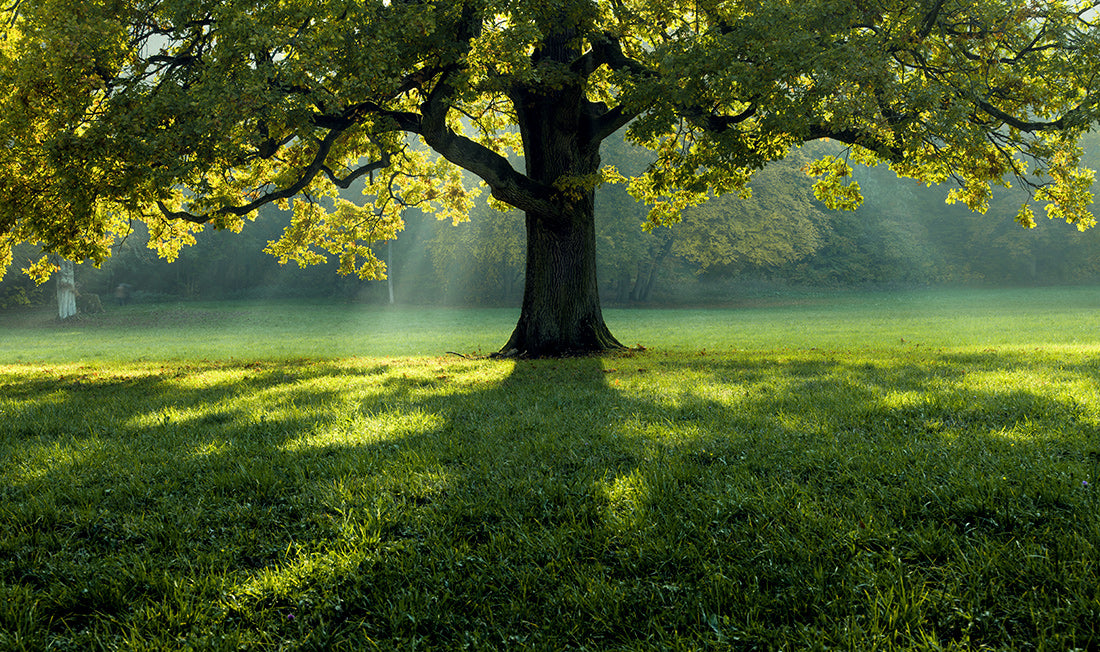There are no two ways about it, managing turfgrass in heavy shade can be a major headache. In addition to reducing the amount of light that your turf receives, shade can also alter the environment in which your turf resides, which can affect the long-term viability of your lawn. Here’s how shade influences the growth of your grass:
Reduced irradiance - Reduces the total amount of light that your lawn receives. Light powers the food production that your lawn requires in order to store food for times of stress and fuel plant growth in order to harness even more energy from the sun.
Decreased light quality - When light passes through the canopy of a tree, the light that actually makes it to your turf will contain a higher proportion of far red wavelengths compared to red wavelengths. This causes the grass to put energy toward leaf elongation rather than root and stem growth. This results in etiolation of your turf, causing a thin, sickly look.

Restricted air movement - The object or structure casting the shade is most likely also decreasing wind and air movement in the surrounding environment. Stagnant air can stress your turf as it can restrict transpiration, which is necessary for the movement of nutrients from soil solution into the grass plant. Transpirational cooling is also how your grass beats the heat on summer days.
Increased humidity - Increased humidity is great for fungal pathogens and can stress your turf. If the humidity is too high, there isn’t a large enough difference in water potential from the leaf to the air. This can restrict the process of transpiration as the air can longer hold additional water, like that which evaporates from your lawn via transpiration.

Extended dew persistence - Dew evaporates much faster in the sunlight. The longer that your turf canopy remains wet, the longer you’re creating a favorable environment for fungal pathogens looking to infect your lawn.

All of this adds up to growing grass that has access to less than adequate light energy but is using the energy it does create for shoot growth, rather than a dense root system. This is all happening in an environment that favors the growth of infectious pathogens. Doesn’t exactly sound like a “great time” for your turf. There are ways that we can swing the momentum in favor of your grass. So fear not, if you’ve been battling with shade issues, implementing some of the following ideas just might help increase the density and viability of your shaded grass.
Reduce Fertilizer Use - Grass growing in the shade is not growing as quickly as grass that’s soaking up full sun. The slower growth rate means its nitrogen demand drops quite a bit. When fertilizing your shaded turf, it’s a good idea to reduce the amount that you apply compared to what you would apply in full sun. Overfertilizing shaded turf can further degrade the quality of your lawn.
Trim Trees - Limbing up trees that cast an unacceptable amount of shade has the potential to increase sun exposure to your turf. It may not help a ton with increasing overhead midday sun, but it can help increase lower angle sunlight, in the early morning and evening. You can also try increasing light quality by thinning out the canopy of the tree in question. It could help allow more sunlight through the canopy, and in the dense shade, we’ll take any help we can get.

Raise Mowing Height - This is where we try to maximize photosynthesis. Raising your mowing height in the shade increases the amount of leaf area available to photosynthesize. The ability to make food from sunlight is what makes or breaks success here, so anything we can do to maximize food production will be beneficial.

Mulch Leaves - Allowing your leaves to sit, accumulate, and smother your lawn is definitely not going to help anything. If you have the time in the fall, continue using your lawn mower, maybe once per week, to mulch newly fallen leaves. If you stay on top of it, you might not even need to touch a rake, in some places. Plus, mulched leaves are a source of nutrients and organic matter that can condition your soil over time. If you’re not into mulching, at the very least make sure to rake up the leaves a few times throughout the fall, this is a prime opportunity for better sun exposure, as the tree canopy thins and eventually becomes bare. We don’t want fallen leaves blocking the sun from reaching the turf below.
Use A Plant Growth Regulator - Growth regulators like Primo MAXX, Cutless, and Trimmit work by inhibiting the synthesis of the plant growth hormone (gibberellic acid) responsible for signaling leaf growth. With less energy being spent on shoot growth, there is more to put into root growth and tillering. This results in a thicker, denser stand of turf. Before you apply any growth regulators check to make sure that it’s labeled for your specific turfgrass and use.
In conclusion, managing turf in the shade is not impossible. There are plenty of ways that you can help your turf deal with the altered environment produced in shaded conditions. If you’ve exhausted all of the previously mentioned options, and still can’t get your grass to grow, consider going with a planter or garden bed with shade tolerant plants. Grass isn’t meant to be grown everywhere. Having other issues with your lawn? Contact us today for a plan to get your lawn on the right track. Don’t forget to check out our other blogs addressing a variety of lawn care topics.









